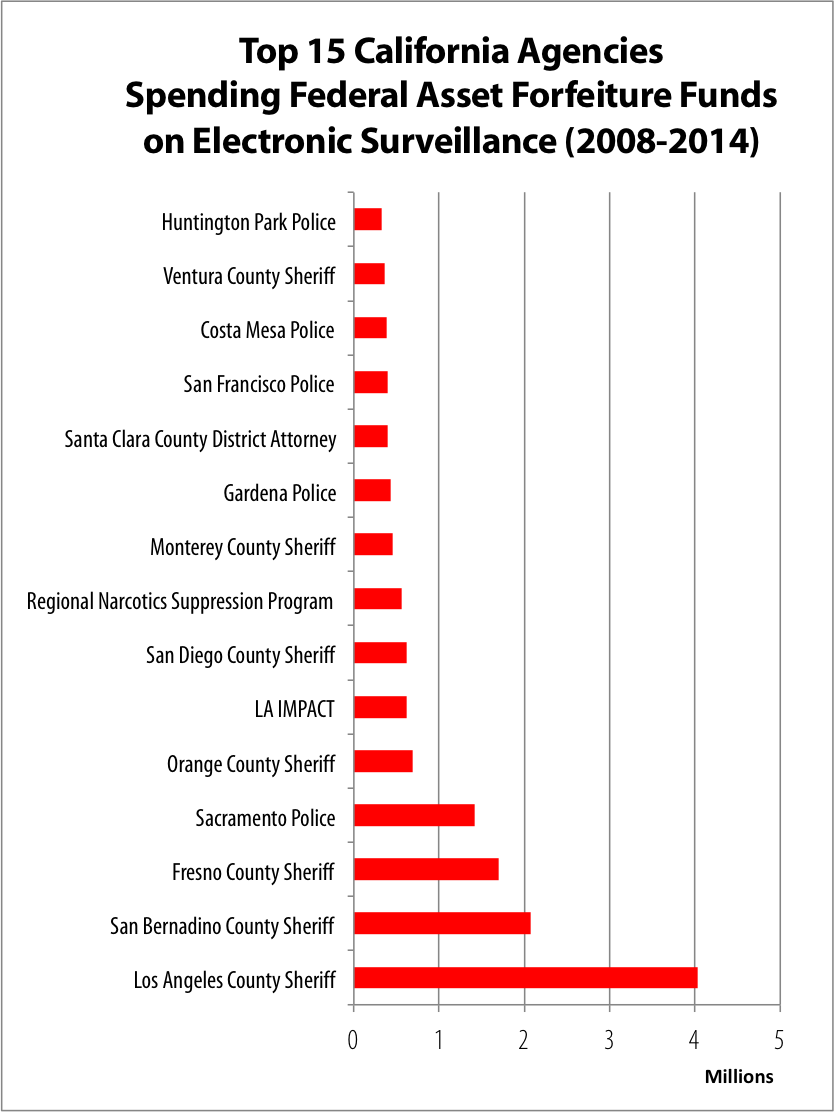 |
| Image: ACLU.org |
Dave Maass
Activist Post
Note: The bulk of the research in this post was compiled prior to Attorney General Eric Holder’s surprise announcement that he is curtailing the federal equitable sharing program. The post may be updated as further ramifications of the policy decision become clear.
“You follow drugs, you get drug addicts and drug dealers. But you start to follow the money, and you don’t know where the f*** it’s gonna take you.”
This oft-cited wisdom comes from Detective Lester Freamon, a character in the classic HBO series The Wire, which tracked how an elite task force of (fictional) Baltimore cops used electronic surveillance to bring down criminal networks. But, the sentiment is ironic to a fault: if you keep following the money, it might take you right back to the police.
Asset forfeiture has long been a topic of controversy in law enforcement. Cops and prosecutors have had the power to seize property and cash from suspects before anyone has actually been convicted of a crime (usually narcotics-related). Then these law enforcement agencies have plugged a portion of that money (and money derived from auctioning of property) into their own budgets, allowing them to spend in ways that possibly would not have passed scrutiny during the formal appropriations process.
Critics note that asset forfeiture creates a perverse incentive for policing priorities: the more assets cops seize, the more money they get to spend. Satirist John Oliver characterized the practice as akin to “legalized robbery by law enforcement” in a must-watch segment on his show Last Week Tonight. News organizations, including New York Times, the New Yorker and the Washington Free Beacon have recently outlined abuses of the system.
The good news is that, on Friday, the Washington Post reported that Attorney General Eric Holder is taking steps to rein in the federal version of the program, barring state and local law enforcement agencies from “using federal law to seize cash, cars and other property without evidence that a crime occurred.”
 Last year, the Washington Post’s investigative team used the Freedom of Information Act to liberate hundreds of thousands of documents associated with federal asset forfeiture, including the entire collection of annual spending disclosures (“Equitable Sharing Agreements”) filed with the U.S. Department of Justice by each individual law enforcement agency and task force across the country that receives these funds. The documents reveal a wide variety of spending, from using seized assets to pay for new vehicles and helicopters, drug “buy” money, payments to confidential informants, travel expenses, law enforcement equipment, and rewards for police, such as “challenge coins.”
Last year, the Washington Post’s investigative team used the Freedom of Information Act to liberate hundreds of thousands of documents associated with federal asset forfeiture, including the entire collection of annual spending disclosures (“Equitable Sharing Agreements”) filed with the U.S. Department of Justice by each individual law enforcement agency and task force across the country that receives these funds. The documents reveal a wide variety of spending, from using seized assets to pay for new vehicles and helicopters, drug “buy” money, payments to confidential informants, travel expenses, law enforcement equipment, and rewards for police, such as “challenge coins.”
An examination of these documents reveal the connection between seized assets and electronic surveillance across the country. It many ways, it has been a circular, self-sustaining system: asset forfeiture helps law enforcement agencies pay for electronic surveillance, which allows cops to seize more money to pay for electronic surveillance.

According to data compiled by the Washington Post for the years 2008-2013, law enforcement agencies around the country collectively spent $121 million of federal asset forfeiture funds on electronic surveillance equipment, an annual nationwide average $20.2 million.
The forms do not clearly define “electronic surveillance,” but it typically includes the type of equipment used in wiretaps. The amount of seized assets spent on electronic surveillance could potentially be much higher, since law enforcement agencies can categorize staff time spent on surveillance in other categories. Sometimes agencies weren’t sure how to categorize certain technologies, such as automatic license plate readers and GPS tracking devices, so they reported them separately under other categories. To put it another way: these numbers are just the chunk of the iceberg viewable through public records.
The data sets are enormous, so let’s drill down on California. Brace yourself, it’s about to get mathy.
How Wiretaps Are Used to Seize Funds
California law enforcement agencies executed 2,078 wiretap orders between 2011 and 2013, according to the California Electronic Interceptions Reports, an annual accounting of electronic surveillance compiled by the California Attorney General’s Office. These reports show that these agencies seize hundreds of millions of dollars each year in wiretap-related criminal investigations, usually involving narcotics or gang activities, and frequently in partnership with federal agencies.
 In Los Angeles County, law enforcement agencies conducted 515 wiretap operations over that three-year period, leading to the seizure of at least $25 million in assets. The California Electronic Interceptions Report provides details on the outcome of every single wiretap, which typically include the number of communications captured, the number of individuals affected by the wiretap, and any arrests made or drugs or assets seized. For example, you might see that one 2013 LA wiretap intercepted 9,273 communications involving 67 people, resulting in a single arrest and the seizure of $427,000 in alleged narcotics proceeds. Or that in 2012, LA authorities captured 6,176 communications involving 245 people, resulting in the seizure of $440,000 in alleged drug money.
In Los Angeles County, law enforcement agencies conducted 515 wiretap operations over that three-year period, leading to the seizure of at least $25 million in assets. The California Electronic Interceptions Report provides details on the outcome of every single wiretap, which typically include the number of communications captured, the number of individuals affected by the wiretap, and any arrests made or drugs or assets seized. For example, you might see that one 2013 LA wiretap intercepted 9,273 communications involving 67 people, resulting in a single arrest and the seizure of $427,000 in alleged narcotics proceeds. Or that in 2012, LA authorities captured 6,176 communications involving 245 people, resulting in the seizure of $440,000 in alleged drug money.
The Cost of Wiretaps
Electronic surveillance isn’t cheap. Between 2011 and 2013, the average cost to execute a wiretap order in California was $40,594, which included $36,807 for staff time and $3,787 for equipment-related expenses.
From a bird’s eye view, California law enforcement agencies collectively spent $84 million on electronic interceptions during that period, an average of $28 million per year. Of that, staff time spent on electronic surveillance cost California agencies $76 million ($25 million annually) and equipment-related expenses cost $7.9 million ($2.6 million annually).
In Los Angeles County alone, law enforcement agencies spent $20.3 million between 2011 and 2013, including $2.1 million on wiretap equipment.
How Seized Assets Were Turned into Electronic Surveillance
When local law enforcement agencies participated in federal investigations, the federal government paid them back by divvying out a portion of the proceeds from the seizures. These agencies included police department, sheriff offices, and district attorney offices, as well as investigative task forces that span multiple jurisdictions. These agencies were required to broadly report how they spent the money in a variety of categories, including electronic surveillance, on an annual basis.
Between 2011 and 2013, law enforcement agencies in California spent a total of $13.6 million in funds from the federal asset forfeiture program on electronic surveillance equipment, a statewide average of $4.5 million per year.
To give a sense of scale: that was enough to cover the cost of wiretap equipment (including installation fees, supplies, and equipment) for the entire state of California, with change left over.
 To look at it another way, that’s enough to pay for equipment in more than 3,500 wiretaps, far more than these agencies actually conducted. This could indicate that either agencies may have bought more equipment than they needed to carry out these wiretaps or that they may have spent significant portions of the money on surveillance that doesn’t require a wiretap order.
To look at it another way, that’s enough to pay for equipment in more than 3,500 wiretaps, far more than these agencies actually conducted. This could indicate that either agencies may have bought more equipment than they needed to carry out these wiretaps or that they may have spent significant portions of the money on surveillance that doesn’t require a wiretap order.
Los Angeles County is made up of dozens of local law enforcement agencies and task forces, but two in particular consistently rose to the top of electronic surveillance spending: the Los Angeles County Sheriff’s Office and Los Angeles Interagency Metropolitan Police Apprehension Crime Team (LA IMPACT), a cross-jurisdictional task force.
The Los Angeles County Sheriff’s Department dug deep into seized federal asset forfeiture funds to run its electronic surveillance operations. Between 2008 and 2014, the LA Sheriff received a total of $47.3 million from the federal program and spent roughly $4 million of that on electronic surveillance equipment. Meanwhile, LA IMPACT received approximately $30 million in asset forfeiture funds over that period, two thirds of which it transferred to other law enforcement agencies. Of the remaining money, about $620,000 went towards electronic surveillance.
That’s how it works (or worked on the federal level before Holder’s announcement): police spend money on electronic surveillance, which leads to the seizure funds from suspected criminals, and then that money is channeled back to police to use on more electronic surveillance.
Holder’s announcement could have a significant impact on how law enforcement agencies fund electronic surveillance. However, it’s important to remember that the next administration’s attorney general could easily reverse this policy decision. Further, many states also have their own asset forfeiture programs, so a whole second layer of funding remains on the state level.
The Washington Post has released its giant cache of Equitable Sharing Agreements from thousands of local law enforcement agencies around the country. We urge you to dig in, find your local cops, identify out how they’ve spend this money, and let the world know what you find.
Major thanks goes out to Washington Post data editor Steven Rich and his colleagues for freeing this data, making it available to the public, and helping us wrap our heads around the spreadsheets.
Please visit the Electronic Frontier Foundation, where this first appeared, for the latest in digital privacy and civil liberties.



Be the first to comment on "Asset Forfeiture and the Cycle of Electronic Surveillance Funding"